MAGI: A Low-Cost IoT Architecture for Distributed AIS-Based Vessel Monitoring and Maritime Emissions Assessment in Panama
Abstract
1. Introduction
- The design and implementation of a low-cost, open-source architecture for real-time AIS data acquisition, utilizing SDR receivers and containerized edge computing platforms.
- Validation of the system in a demanding, real-world maritime environment in Panama, demonstrating high coverage and reliability under field conditions.
- Evaluation of MAGI’s scalability, cost-effectiveness, and operational feasibility for establishing robust coastal monitoring networks in resource-limited contexts.
1.1. AIS Data for Maritime Emissions Assessment
1.2. Low-Cost AIS Acquisition and SDR Solutions
1.3. Distributed IoT Architectures for Monitoring
1.4. Conceptual Grouping and MAGI’s Position
2. Materials and Methods
2.1. System Overview
- The AIS Signal Acquisition Module: This component is responsible for capturing and decoding AIS signals in real time from a remote location.
- The Messaging Middleware Layer: Implemented using Apache Kafka, this layer serves as a central, decoupled data bus that efficiently handles the high volume of AIS messages.
- The Backend Processing Stack: This comprises a series of containerized microservices that process, enrich, and store the AIS data in a PostgreSQL database.
2.2. Hardware Components
2.3. Software Architecture
2.3.1. AIS Capture and Decoding
2.3.2. Kafka Messaging System
2.3.3. Backend and RESTful API
- MAGI-Consumer: Consumes messages from the ‘static-message’ topic, validates them, and sends them to the ‘MAGI-Enricher’ via the ‘scraper-message’ topic for enrichment.
- MAGI-Enricher: Enhances static AIS messages with technical information about vessels (e.g., year built, engine type, dimensions). Once enriched, the data are published back to Kafka in the ‘enriched-message’ topic.
- MAGI-Storage: Is responsible for consuming dynamic messages from the ‘dynamic-message’ topic for persistent storage in the PostgreSQL database.
- MAGI-Exporter: Constitutes the RESTful API that exposes the stored data through a public endpoint (‘/export/ship-positions’), allowing data to be exported in formats compatible with external analysis systems. Figure 4 illustrates an end-to-end data pipeline for processing AIS signals.
2.3.4. PostgreSQL Database
2.3.5. Containerization with Docker and Docker Compose
2.3.6. Private Network and Remote Access with Tailscale VPN
2.4. Data Validation and Consistency
- NMEA Frame Validation (Edge Layer): The ais-decoder microservice first performs a basic integrity check on the incoming NMEA-0183 messages received from ais-catcher. This includes verifying the checksum and message length to filter out corrupted frames caused by environmental noise or poor signal reception.
- Schema Consistency (Storage Layer): The MAGI-Storage service applies strict schema validation before persistence. Data types are verified against the predefined PostgreSQL table schema. Furthermore, the ships table uses the MMSI (Maritime Mobile Service Identity) as the primary key, ensuring referential integrity and preventing duplication of static vessel information.
2.5. Deployment Site and Experimental Protocol
- Number of AIS messages received per minute.
- Number of unique vessels detected.
- Maximum detection range (in nautical miles).
- Frequency and type distribution of AIS messages.
- Availability and resource usage of backend services.
3. Results and Discussion
3.1. Cost-Performance and Energy Trade-Off Analysis
- Autonomy: The average power draw of 5 W allows the system to be sustainably powered using small, cost-effective solar power systems. For instance, a basic 50 W solar panel with a small battery (e.g., 50 Ah) can ensure continuous 24/7 operation, providing energy autonomy critical for remote coastal sites.
- Thermal Management: The low power dissipation reduces the thermal load inside the protective enclosure, simplifying the cooling requirements and increasing the long-term reliability of the system’s electronic components in hot climates.
3.2. System Performance: Coverage and Message Rate
3.3. Real-Time Response Time and Reliability
4. Conclusions and Future Work
Author Contributions
Funding
Institutional Review Board Statement
Informed Consent Statement
Data Availability Statement
Acknowledgments
Conflicts of Interest
Abbreviations
| MAGI | Monitoring and Analysis of Gases and Emissions |
| AIS | Automatic Identification System |
| MMSI | Maritime Mobile Service Identity |
| NMEA | National Marine Electronics Association |
| VHF | Very High Frequency |
| VTS | Vessel Traffic Service |
| IoT | Internet of Things |
| SDR | Software-Defined Radio |
| API | Application Programming Interface |
| SOx | Sulfur Oxides |
| SO2 | Sulfur Dioxide |
| NOx | Nitrogen Oxides |
| CO2 | Carbon Dioxide |
References
- United Nations Conference on Trade and Development. Review of Maritime Transport 2023; UNCTAD: Geneva, Switzerland, 2023. [Google Scholar]
- AirClim; Seas At Risk; Bellona Foundation; North Sea Foundation; Transport and Environment; European Environmental Bureau. Air Pollution from Ships; Technical Report; Air Pollution and Climate Secretariat (AirClim): Gothenburg, Sweden, 2011. [Google Scholar]
- International Maritime Organization. Reducing Greenhouse Gas Emissions from Ships. 2024. Available online: https://www.imo.org/en/OurWork/Environment/Pages/Air-Pollution.aspx (accessed on 30 July 2024).
- Caprace, J.D.; Monteiro, G.P.; Vitor, J.; De Oliveira Moita, M.; Cepeda, M.A.F. Estimating Ship Emissions Based on AIS Big Data for the Port of Rio de Janeiro. In Proceedings of the 17th International Conference on Computer Applications and Information Technology in the Maritime Industries (COMPIT 2018), Pavone, Italy, 14–16 May 2018. [Google Scholar]
- European Environment Agency. EMEP/EEA Air Pollutant Emission Inventory Guidebook 2023; EEA Report 06/2023; European Environment Agency: Copenhagen, Denmark, 2023; Available online: https://www.eea.europa.eu/en/analysis/publications/emep-eea-guidebook-2023 (accessed on 25 April 2025).
- jvde. AIS-Catcher. 2021. Available online: https://github.com/jvde-github/AIS-catcher (accessed on 17 September 2025).
- U.S. Coast Guard Navigation Center. Automatic Identification System (AIS) Overview. 2025. Available online: https://www.navcen.uscg.gov/automatic-identification-system-overview (accessed on 16 September 2025).
- Ribeiro da Silva, J.N.; Santos, T.A.; Teixeira, A.P. Methodology for Predicting Maritime Traffic Ship Emissions Using Automatic Identification System Data. J. Mar. Sci. Eng. 2024, 12, 320. [Google Scholar] [CrossRef]
- Kwon, J.W.; Yeo, S.; Lee, W.J. Assessment of Shipping Emissions on Busan Port of South Korea. J. Mar. Sci. Eng. 2023, 11, 716. [Google Scholar] [CrossRef]
- Kwon, Y.; Lim, H.; Lim, Y.; Lee, H. Implication of activity-based vessel emission to improve regional air inventory in a port area. Atmos. Environ. 2019, 203, 262–270. [Google Scholar] [CrossRef]
- Eyring, V.; Köhler, H.W.; Lauer, A.; Lemper, B. Emissions from international shipping: 2. Impact of future technologies on scenarios until 2050. J. Geophys. Res. Atmos. 2005, 110, D17306. [Google Scholar] [CrossRef]
- Yoon, J.H.; Kim, S.W.; Eom, J.O.; Oh, J.; Kim, H.J. Coastal Air Quality Assessment through AIS-Based Vessel Emissions: A Daesan Port Case Study. J. Mar. Sci. Eng. 2023, 11, 2291. [Google Scholar] [CrossRef]
- Navarro, K.; Canto, F.; Poveda, H. La radio definida por software como herramienta de aprendizaje educativa en comunicaciones inalámbricas. In Proceedings of the The 16th LACCEI International Multi-Conference for Engineering, Education, and Technology: “Innovation in Education and Inclusion”, Lima, Peru, 19–21 July 2018. [Google Scholar]
- Delás Castellá, H. Desarrollo de un Terminal AIS Low-Cost para Seguimiento de Barcos. Bachelor’s Thesis, Universitat Politècnica de València, Valencia, Spain, 2018. Available online: http://hdl.handle.net/10251/108859 (accessed on 28 October 2025).
- Kpler. MarineTraffic Data Services. 2025. Available online: https://www.kpler.com/product/maritime/data-services (accessed on 28 April 2025).
- VesselFinder. API for AIS Data—VesselFinder Documentation. 2025. Available online: https://api.vesselfinder.com/docs/ (accessed on 28 April 2025).
- Shakespeare Electronic Products Group. Style 5250-AIS. 2021. Available online: https://shakespeare-marine.com/wp-content/uploads/2021/09/5250-ais.pdf (accessed on 16 September 2025).
- NooElec. Nooelec NESDR SMArt v5 SDR-HF/VHF/UHF (100kHz–1.75GHz) RTL-SDR. RTL2832U & R820T2-Based Software Defined Radio. 2025. Available online: https://www.nooelec.com/store/sdr/sdr-receivers/nesdr-smart-sdr.html (accessed on 17 September 2025).
- Orange Pi. Orange Pi 5B-Orange Pi-Orangepi. 2025. Available online: http://www.orangepi.org/html/hardWare/computerAndMicrocontrollers/details/Orange-Pi-5B.html (accessed on 17 September 2025).
- Apache Software Foundation. Apache Kafka. 2025. Available online: https://kafka.apache.org/ (accessed on 17 September 2025).
- The PostgreSQL Global Development Group. PostgreSQL: The World’s Most Advanced Open Source Database. 2025. Available online: https://www.postgresql.org/ (accessed on 17 September 2025).
- Docker, Inc. Docker: Accelerated Container Application Development. 2025. Available online: https://www.docker.com/ (accessed on 17 September 2025).
- Hidalgo Rodríguez, M.D.J. Raw Automatic Identification System (AIS) Data and Vessel Metadata from the MAGI Platform. Dataset. 2025. Available online: https://doi.org/10.5281/zenodo.17298800 (accessed on 9 October 2025).




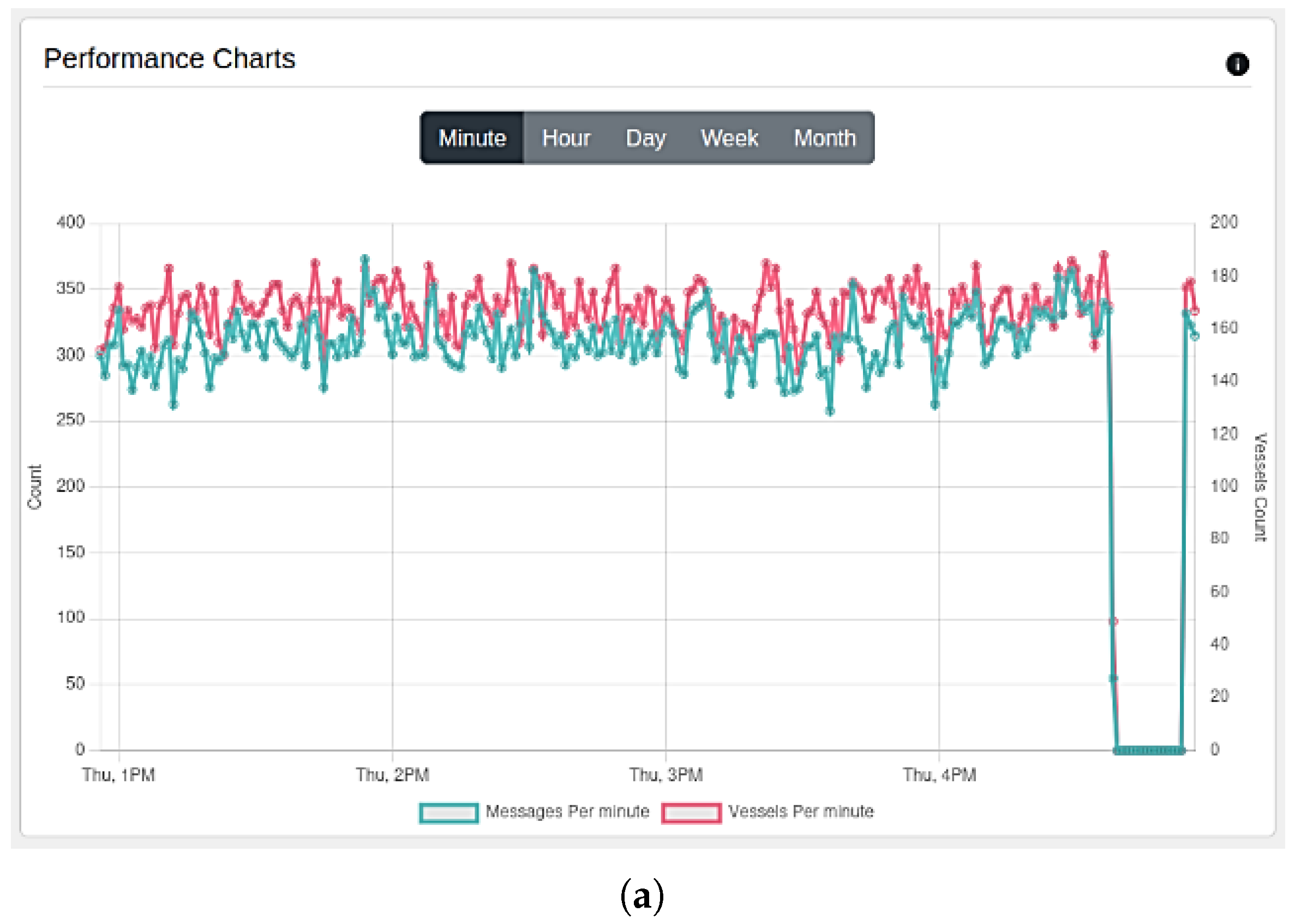
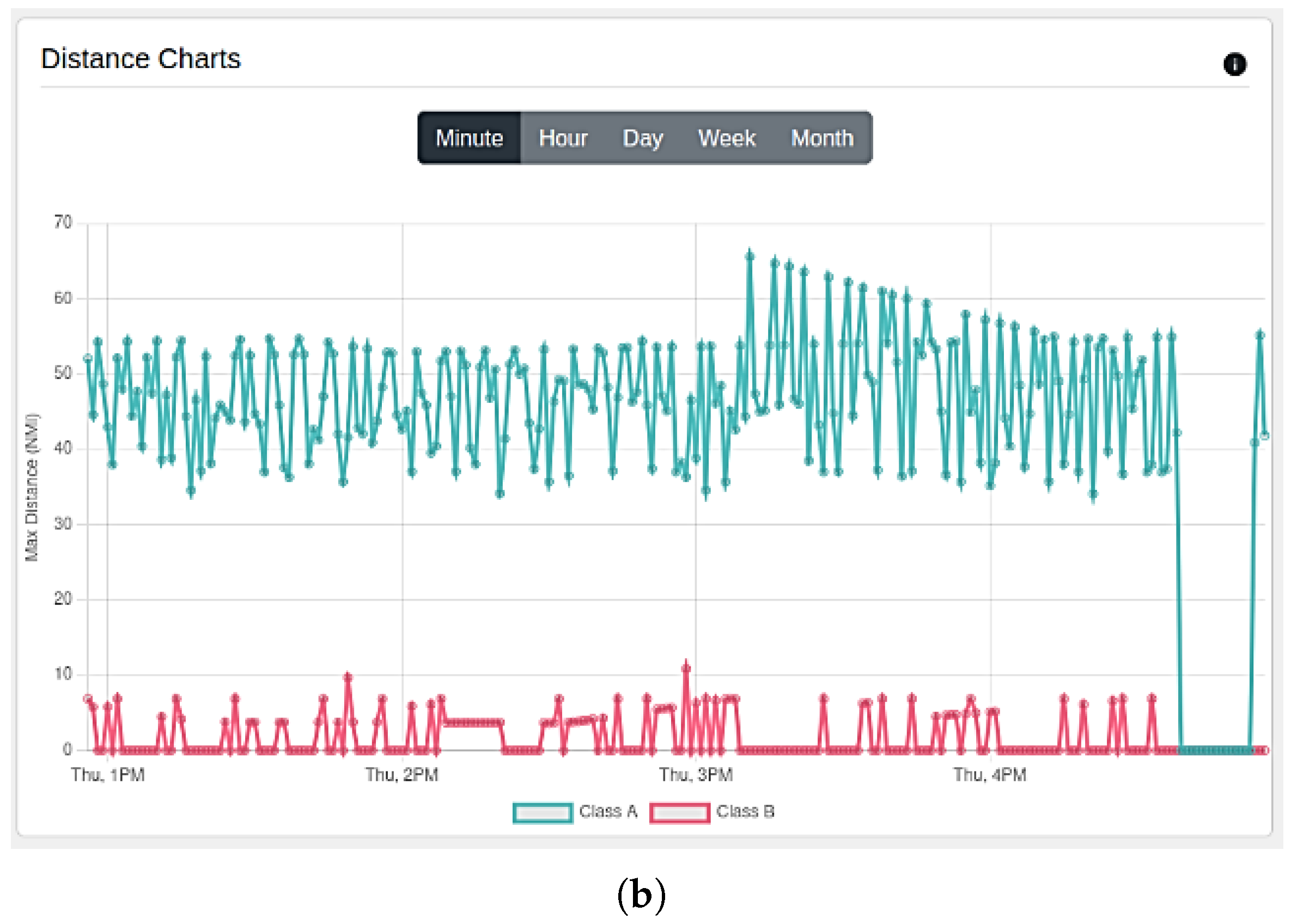
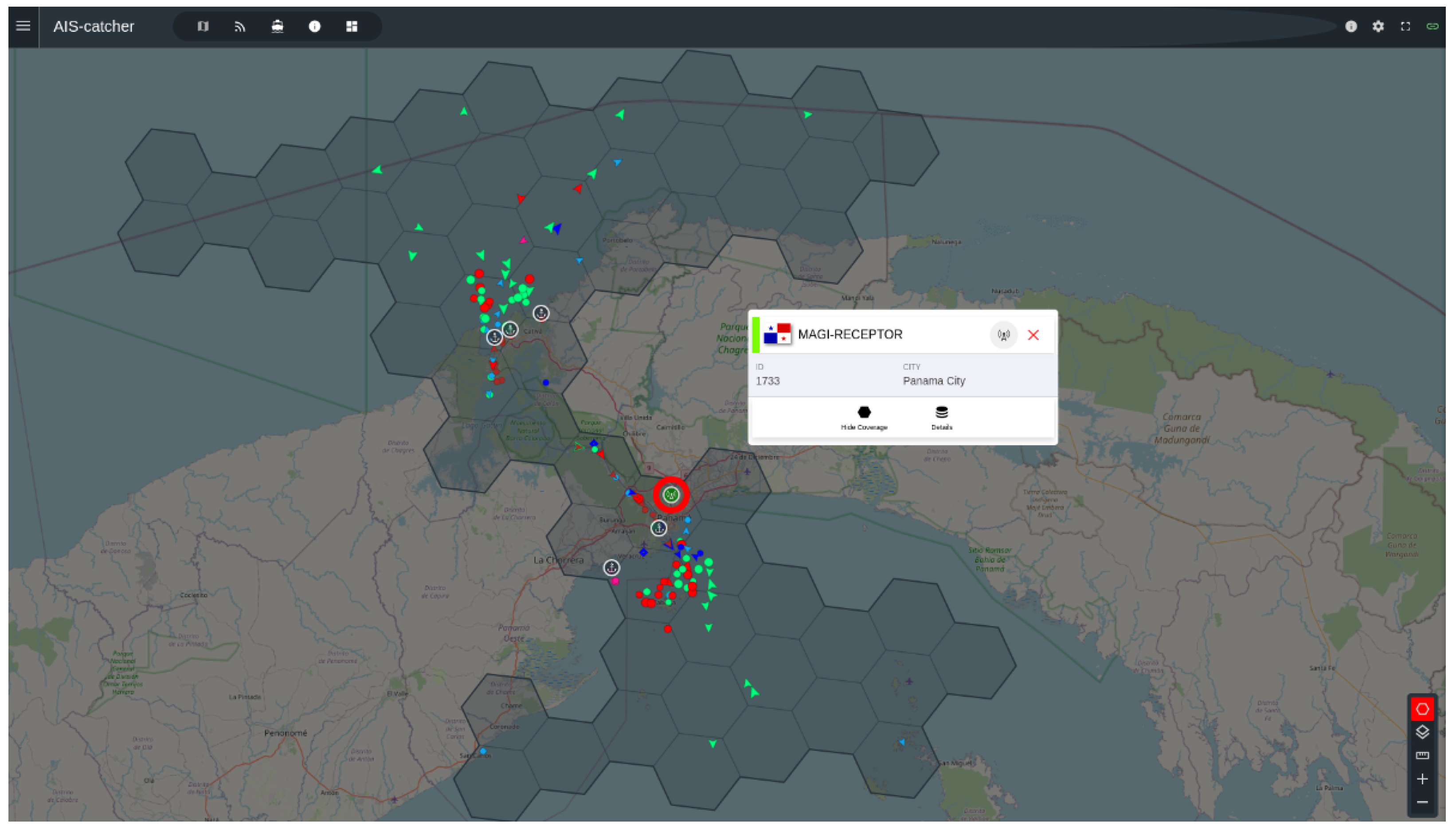
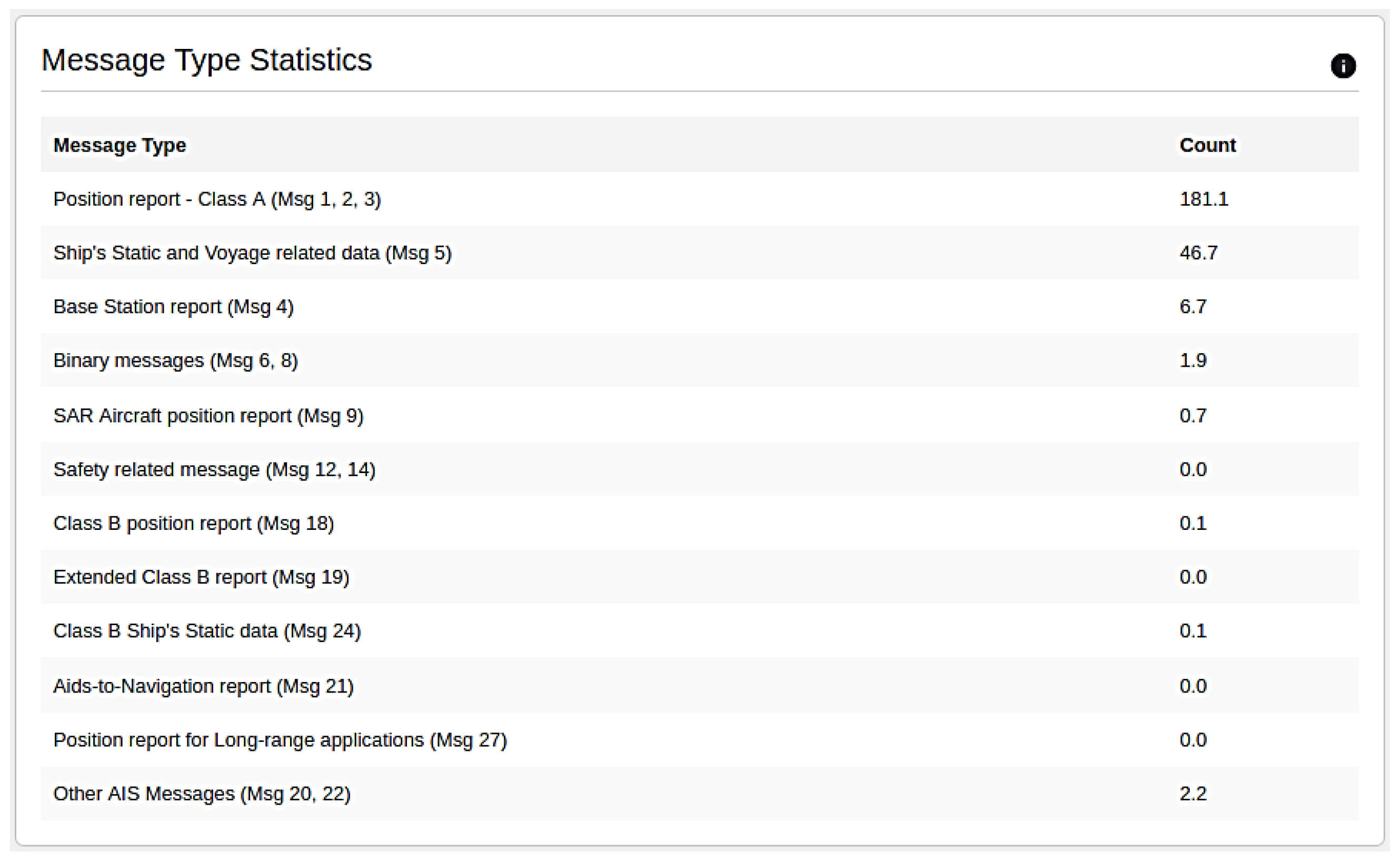
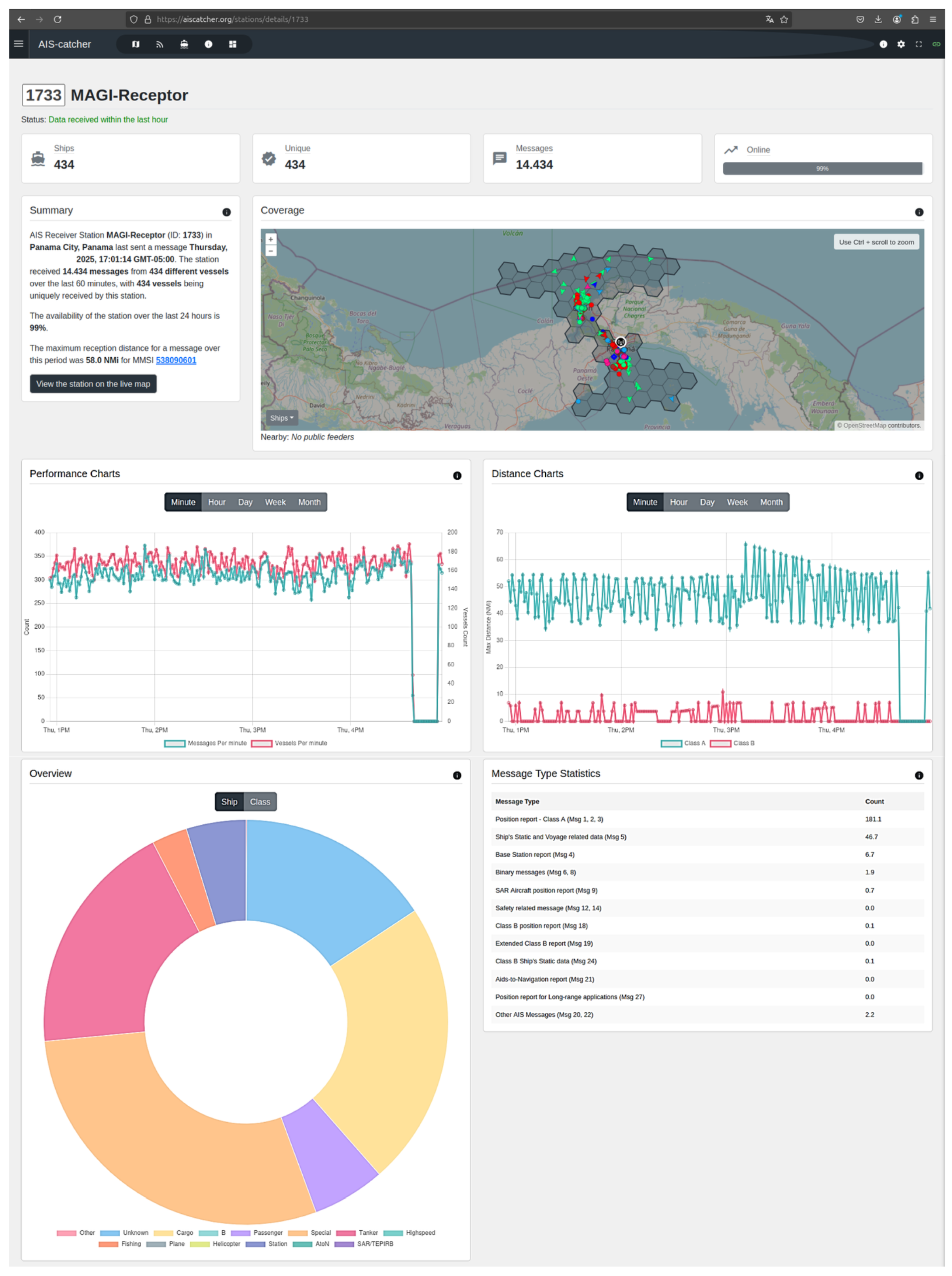
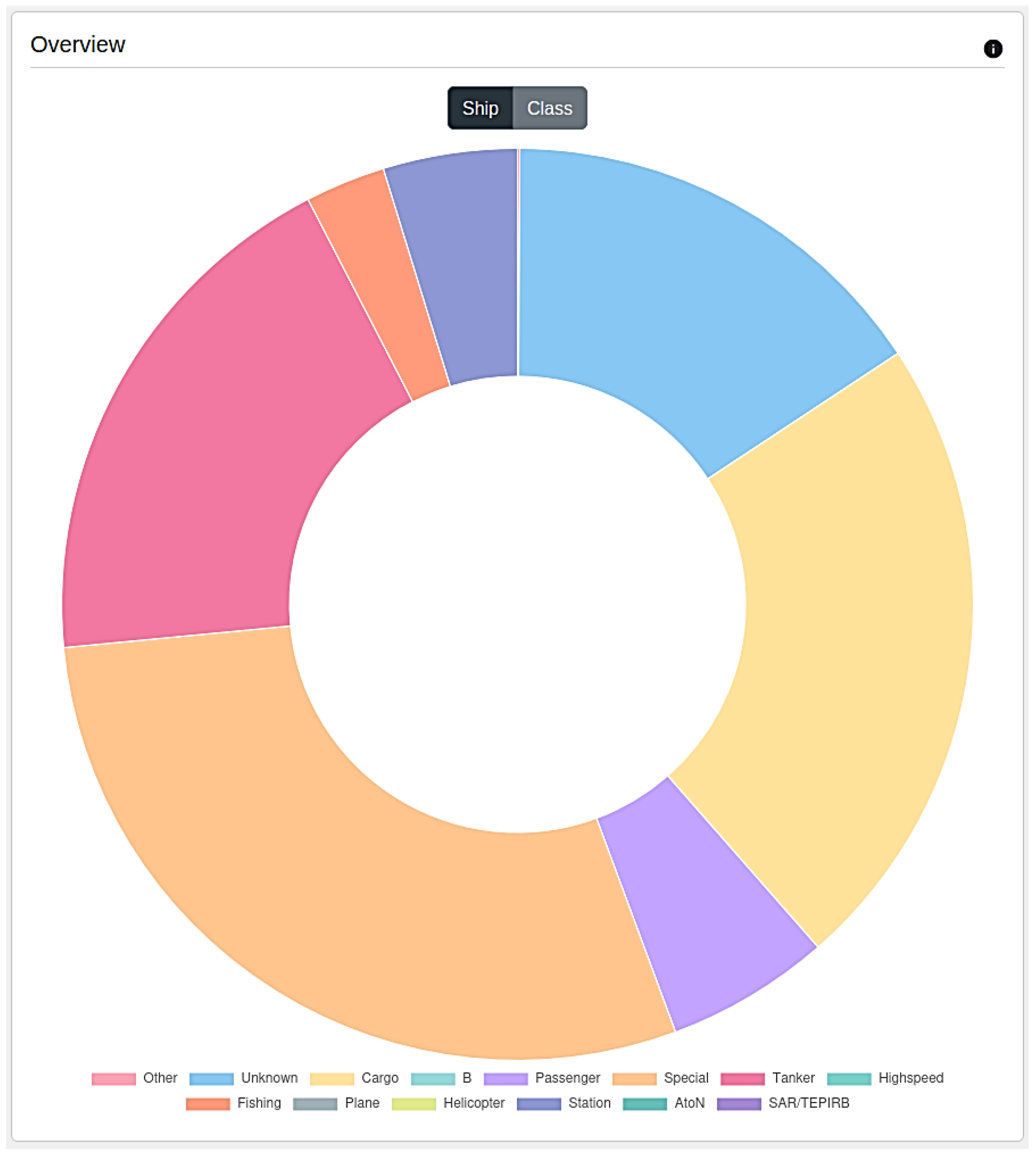
| Feature/System Type | Commercial Platforms | AIS Emissions Studies | MAGI Architecture (This Work) |
|---|---|---|---|
| Cost of Hardware/License | High | High/Proprietary | Low/Open-Source |
| Access to Raw AIS Data | No (Position only) | Limited/Expensive | Yes (Distributed/API) |
| Data Pipeline (Kafka/MQ) | Proprietary/Internal | Absent/Custom | Integrated (Kafka) |
| Edge Computing | Absent/Centralized | Absent/Centralized | Integrated (Containerized) |
| Scalability/Distribution | High (Cloud) | Low (Site-specific) | High (Distributed Edge) |
| Applicability in Dev. Regions | Low | Low | High |
| Component | Role | Language/Framework | Version | Manufacturer |
|---|---|---|---|---|
| ais-catcher [6] | SDR Decoder | C | 0.17 | Independent Developer, Austria |
| Docker | Containerization | - | 24.0.5 | Docker Inc., Palo Alto, CA, USA |
| Docker Compose | Orchestration | - | 2.20.2 | Docker Inc., Palo Alto, CA, USA |
| Apache Kafka [20] | Messaging Middleware | Scala/Java | 3.9 | Apache Software Foundation, Wakefield, MA, USA |
| PostgreSQL [21] | Database | - | 15.0 | PostgreSQL Global Development Group, Berkeley, CA, USA |
| MAGI Microservices | Processing Logic | Python/Go | 3.10/23.5 | Our |
Disclaimer/Publisher’s Note: The statements, opinions and data contained in all publications are solely those of the individual author(s) and contributor(s) and not of MDPI and/or the editor(s). MDPI and/or the editor(s) disclaim responsibility for any injury to people or property resulting from any ideas, methods, instructions or products referred to in the content. |
© 2025 by the authors. Published by MDPI on behalf of the International Institute of Knowledge Innovation and Invention. Licensee MDPI, Basel, Switzerland. This article is an open access article distributed under the terms and conditions of the Creative Commons Attribution (CC BY) license (https://creativecommons.org/licenses/by/4.0/).
Share and Cite
Hidalgo-Rodriguez, M.; Cruz, E.; Pinzon-Acosta, C.; Gonzalez-Olivardia, F.; Rangel, J.C. MAGI: A Low-Cost IoT Architecture for Distributed AIS-Based Vessel Monitoring and Maritime Emissions Assessment in Panama. Appl. Syst. Innov. 2025, 8, 177. https://doi.org/10.3390/asi8060177
Hidalgo-Rodriguez M, Cruz E, Pinzon-Acosta C, Gonzalez-Olivardia F, Rangel JC. MAGI: A Low-Cost IoT Architecture for Distributed AIS-Based Vessel Monitoring and Maritime Emissions Assessment in Panama. Applied System Innovation. 2025; 8(6):177. https://doi.org/10.3390/asi8060177
Chicago/Turabian StyleHidalgo-Rodriguez, Miguel, Edmanuel Cruz, Cesar Pinzon-Acosta, Franchesca Gonzalez-Olivardia, and José Carlos Rangel. 2025. "MAGI: A Low-Cost IoT Architecture for Distributed AIS-Based Vessel Monitoring and Maritime Emissions Assessment in Panama" Applied System Innovation 8, no. 6: 177. https://doi.org/10.3390/asi8060177
APA StyleHidalgo-Rodriguez, M., Cruz, E., Pinzon-Acosta, C., Gonzalez-Olivardia, F., & Rangel, J. C. (2025). MAGI: A Low-Cost IoT Architecture for Distributed AIS-Based Vessel Monitoring and Maritime Emissions Assessment in Panama. Applied System Innovation, 8(6), 177. https://doi.org/10.3390/asi8060177







